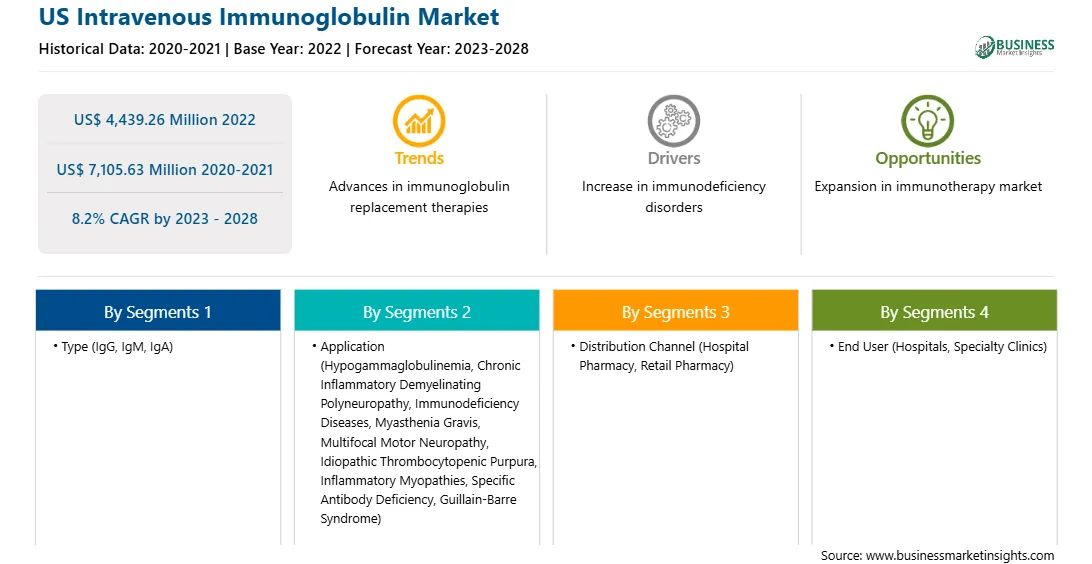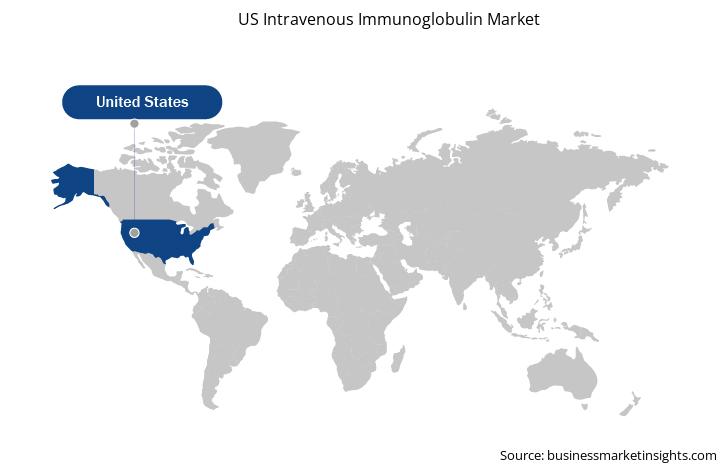The increasing geriatric population favors the growth of the US intravenous immunoglobulin market.
Immunoglobulins are the antibodies produced naturally by the body’s immune system, which help fight infection and disease. Individuals with immunoglobulin deficiency require the external administration of immunoglobulin and known as immunoglobulin replacement therapy (IgRT). IgRT can be given intravenously and subcutaneously. Intravenous immunoglobulin (IVIg) and subcutaneous immunoglobulin (SCIg) are selected based on the indication and severity. IVIgs are extracted from human plasma. These antibodies are used in the treatment of various immunological, hematological, and neurological illnesses. Factors such as rising immunodeficiency disease prevalence and increasing geriatric population in the US drive the US intravenous immunoglobulin market growth. However, adverse effects of immunoglobulin therapy hamper the market growth.
IVIGs are used to treat patients suffering from primary and secondary immunodeficiencies and autoimmune disorders. The IVIG is a standard therapy to treat most primary immunodeficiencies (PIDs). According to data by John Hopkins Medicine, ~3% of the total US population, i.e., 10 million people, suffers from autoimmune diseases. As per the National Institute of Allergy and Infectious Diseases (NIAID), there are over 200 different types of primary immune deficiency diseases (PIDDs) affecting ~500,000 people in the US. The rare genetic diseases can be chronic, weakening, and expensive to treat. Immune Thrombocytopenia (ITP) is an autoimmune bleeding disorder characterized by abnormally low levels of platelets; a situation referred to as thrombocytopenia. The Rare Diseases Organization states that the incidence rate of ITP in adults is ~3.3 per 100,000 per year in the US. Per the National Multiple Sclerosis Society study report, published in 2019, ~1 million adults (~913,925) were affected by multiple sclerosis (MS) in the US. According to the MS Discovery Forum, ~200 new cases are diagnosed each week in the US. Thus, the increasing prevalence of immunodeficiency diseases drives the growth of the US intravenous immunoglobulin market.
Many market players and research institutes operating in the US intravenous immunoglobulin market are developing advanced technologies to expand their product portfolios and increase their market shares. Rising immunodeficiency disease prevalence, product approvals, and collaborations are among the factors driving the US intravenous immunoglobulin market size.
A few of the recent developments related to US intravenous immunoglobulin are mentioned below:
Based on product type, the US intravenous immunoglobulin market is segmented into IgG, IgM, IgA, and others. In 2022, the IgG segment held the largest share of the market. Moreover, the same segment is expected to record the highest CAGR during the forecast period.
IVIg is a replacement therapy and treatment for patients with antibody deficiencies or for those who suffer from immunodeficiency disorders. For instance, in primary or secondary hypogammaglobulinemia, IVIg replacement therapy provides protection against infections by administering an adequate volume of IgG in the blood. IVIg is a blood product prepared from serum derived from 1,000–15,000 donors per batch where only IgG is purified from plasma to produce IVIg products. Therefore, IVIg used for treatment therapies contains 95–98% pure IgG with small amounts of other plasma proteins, including IgA and IgM.
Thus, wide applications of IgG in treating several categories of disorders are among the factors contributing to the growth of the US intravenous immunoglobulin market.
The US intravenous immunoglobulin market, based on end user, is segmented into hypogammaglobulinemia, chronic inflammatory demyelinating polyneuropathy (CIDP), immunodeficiency diseases, myasthenia gravis (MG), multifocal motor neuropathy (MMN), idiopathic thrombocytopenic purpura (ITP), inflammatory myopathies, specific antibody deficiency (SDA), Guillain-Barre syndrome (GBS), and others. In 2022, the immunodeficiency diseases segment held the largest market share in . The same segment is expected to grow at the fastest rate during the coming years.
The World Health Organization (WHO), the US Census Bureau, and the US National Library of Medicine are a few of the major primary and secondary sources referred to while preparing the report on the US intravenous immunoglobulin market.
Strategic insights for the US Intravenous Immunoglobulin provides data-driven analysis of the industry landscape, including current trends, key players, and regional nuances. These insights offer actionable recommendations, enabling readers to differentiate themselves from competitors by identifying untapped segments or developing unique value propositions. Leveraging data analytics, these insights help industry players anticipate the market shifts, whether investors, manufacturers, or other stakeholders. A future-oriented perspective is essential, helping stakeholders anticipate market shifts and position themselves for long-term success in this dynamic region. Ultimately, effective strategic insights empower readers to make informed decisions that drive profitability and achieve their business objectives within the market.

| Report Attribute | Details |
|---|---|
| Market size in 2022 | US$ 4,439.26 Million |
| Market Size by 2028 | US$ 7,105.63 Million |
| Global CAGR (2023 - 2028) | 8.2% |
| Historical Data | 2020-2021 |
| Forecast period | 2023-2028 |
| Segments Covered |
By Type
|
| Regions and Countries Covered | United States
|
| Market leaders and key company profiles |
The geographic scope of the US Intravenous Immunoglobulin refers to the specific areas in which a business operates and competes. Understanding local distinctions, such as diverse consumer preferences (e.g., demand for specific plug types or battery backup durations), varying economic conditions, and regulatory environments, is crucial for tailoring strategies to specific markets. Businesses can expand their reach by identifying underserved areas or adapting their offerings to meet local demands. A clear market focus allows for more effective resource allocation, targeted marketing campaigns, and better positioning against local competitors, ultimately driving growth in those targeted areas.

The US Intravenous Immunoglobulin Market is valued at US$ 4,439.26 Million in 2022, it is projected to reach US$ 7,105.63 Million by 2028.
As per our report US Intravenous Immunoglobulin Market, the market size is valued at US$ 4,439.26 Million in 2022, projecting it to reach US$ 7,105.63 Million by 2028. This translates to a CAGR of approximately 8.2% during the forecast period.
The US Intravenous Immunoglobulin Market report typically cover these key segments-
The historic period, base year, and forecast period can vary slightly depending on the specific market research report. However, for the US Intravenous Immunoglobulin Market report:
The US Intravenous Immunoglobulin Market is populated by several key players, each contributing to its growth and innovation. Some of the major players include:
The US Intravenous Immunoglobulin Market report is valuable for diverse stakeholders, including:
Essentially, anyone involved in or considering involvement in the US Intravenous Immunoglobulin Market value chain can benefit from the information contained in a comprehensive market report.